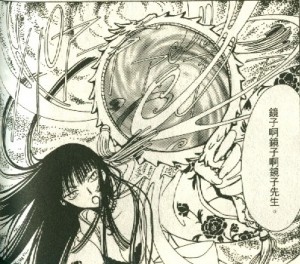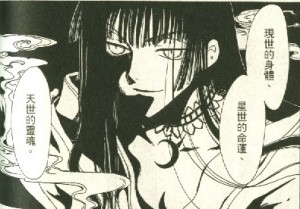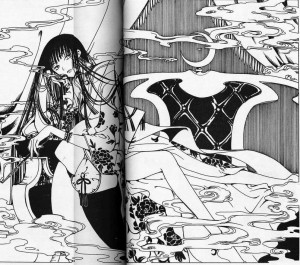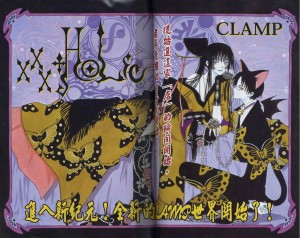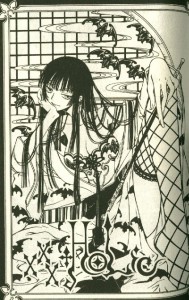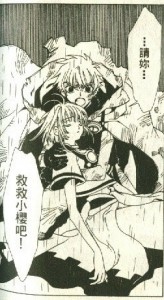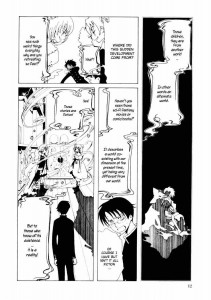This is the latest post in a roundtable on Clamp’s xxxholic.
______________________
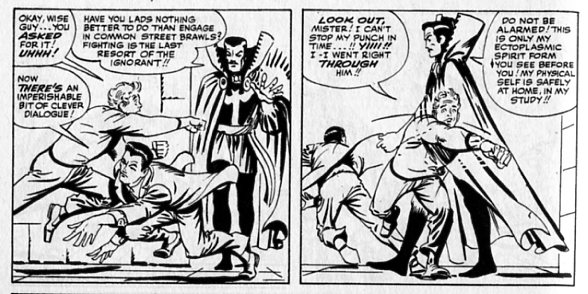
That’s a sequence from the Lee/Ditko Spider-Man Annual #1. I first saw it when I was 8 or so, and it’s stuck with me to this day. Not that I especially loved it or hated it — it’s obviously a fairly bland and pointless sequence.
That very blandness, though, was what arrested me. I couldn’t figure out why I was reading this. Okay, there’s a Spider-Man story…and then Dr. Strange shows up, and walks through four panels — and then he leaves. At other points in the story, Thor passes through in a similar way, as do the Avengers, as do the Fantastic Four. I think I knew even back then who all these characters were, but having them used in this way, for background cameos, left my eight-year old self completely non-plussed. What was the point? Was I supposed to enjoy this? How come?
Of course, I get it now. Dr. Strange walked through so that they could put “Special Guest Stars: Thor! the Avengers! Dr. Strange!” or some such on the cover. It’s a bait and switch.
Or is it? Not exactly, I don’t think. It certainly is a marketing gimmick, but the gimmick isn’t a cheat. Yes Dr. Strange is promised, and you barely get Dr. Strange at all. But I don’t think that’s likely to have been a disappointment to the readers. Rather, the very gratuitousness of the cameo — the fact that Dr. Strange doesn’t do anything and really has no reason for being there — is the point of the whole exercise. He’s trotted out so Marvel loyalists can basically say, “Hey! I know Dr. Strange! There he is! Right in the same world as Spider-Man! Whoo hoo!” The exercise is validated by the little frisson of pleasure you get from catching an allusion. If Dr. Strange were actually part of the plot, if Lee and Ditko had to explain what he was doing there and why he was involved, he wouldn’t work nearly as well as fan-service. He’s an extra bonus for true-believers — the crossover equivalent of a panty shot. The cutesy crassness isn’t a bug; it’s a feature. You pander to let your audience know you’re pandering. It’s a way of saying, hey, plot, theme, character…who cares? The point is that I know you’re reading, you reader you, and I’m looking out for you. Kawaii lecteur,—mon semblable,—mon frère!
This kind of crossover porn has largely been replaced in American superhero comics by continuity porn — an altogether more depressing line of country. But at least for the first three volumes I read, xxxholic keeps things old school: the series is filled with allusions to other Clamp titles, but those allusions are all deliberately and even egregiously shallow. A glimpse of Cardcaptor Sakura’s staff shows up here; a purchase is made from Legal Drug there, little fuzzy bunny things show up from some other Clamp series there.
Even when Clamp flirts with continuity (as when characters from the simultaneously serialized Tsubasa pop in for an inter-dimensional walk-on) it’s very circumspect. Obviously, Clamp would like you to go buy Tsubasa as well as xxxholic, but they’re not going to be pushy about it. Instead, they’re going to be cute:
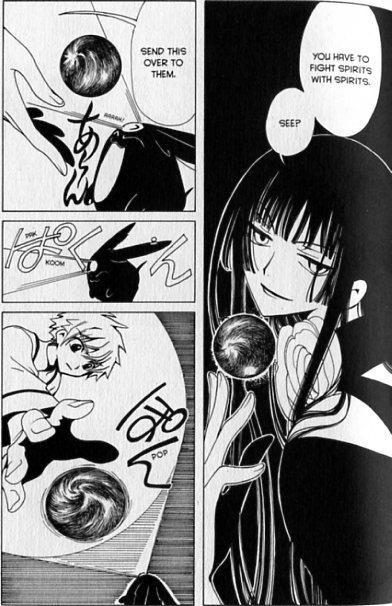
Yes, the little bunnies are a kind of dimensional vortex; you feed a useful item to the black bunny in xxxholic, it pops out of the mouth of the white bunny in Tsubasa. Watch bunnies ingest and egest from multiple angles when you collect them all!
There’s a kind of brilliance in that; the Dr. Strange cameo is cutesy in a somewhat sublimated, nudge-nudge way . So why not just drag that out in the open and have the container be as cutesy as the content? Clamp is better at being Stan Lee than Stan Lee ever was, in some sense. The clubby Marvel in-group of true believers could never attain the insular hothouse fervor of the fan-fic doujinshi circles that spawned Clamp.
I can admire that about Clamp. There’s something almost awe-inspiring in the way they combine the blatant enthusiasms of the amateur with the absolute polish of a professional. They give their audience what they want, and they do it without the audible grinding of gears you always got from those old Marvel comics. When Dr. Strange trots across the page, you can see Stan behind him pushing; the whole thing smells of greasepaint and pasteboard. In Clamp, on the other hand, the crossovers slide across the page so sinuously that if you’re not in the know you’ll never see them. Kinukitty, for example, had to point out the Legal Drug reference to me.
Even though I’m impressed with the craft, though, I have to say that, overall, I still agree with my eight year old self. I mean, yes, I enjoy hearing a familiar sample in a hip hop song, and I liked some of League of Extraordinary Gentleman. But there’s more happening in hip hop or Alan Moore than just dog whistles and secret handshakes. I don’t really open a comic to see Dr. Strange trotted out clumsily, or Legal Drug trotted out subtly. I don’t really want to be nudged by the writer and told that he or she knows these characters too, and isn’t that great. I don’t go to art to be inducted into a club — or, I don’t know, maybe this is just the wrong sort of club for me. In any case, the crossover porn in xxxholic had more or less the opposite effect on me from what was intended. Instead of convincing me want to go out and read the other Clamp series referenced, it made me want to avoid them all, even those, like Cardcaptor Sakura, that I had already read and enjoyed.
______________________
I also wanted to respond to Suat, who, along with Matthias Wivel in comments wondered why critics in general, and me in particular, weren’t harder on mainstream Japanese comics and more appreciative of American literary comics. Suat suggested the leniency might be attributable to some kind of Japanophiliac “cultural forbearance”; Matthias countered with the theory that it was a species of hipster contrarianism. (Update: Altered somewhat for clarity.)
Of course, my last mainstream manga review wasn’t lenient at all. In fact, it was so unlenient it prompted Suat to intimate that my perspective might actually be racist.
But the real point, I think, is that there’s a tendency when you don’t agree with someone on aesthetics to assume that they’re putting you on. Oh, you can’t possibly like Mariah Carey more than Dirty Projectors, you’re just saying that to be contrary. This despite the fact that Mariah Carey actually has a bigger audience than the Dirty Projectors overall, and therefore you might reasonably conclude that liking her more is the default position, and liking the Dirty Projectors the contrarian one….but I digress.
Anyway, I explain at some length starting here some of the reasons that I find shojo more appealing than American literary comics. Also, just on a basic level, I tend to be more impressed with the craft in manga than with that in American comics, though obviously there’s a lot of individual variation. Japanese illustration is an amazing tradition, richer in many ways than the Western one, and it shows.
Despite all that, though, I still don’t like xxxholic much.



